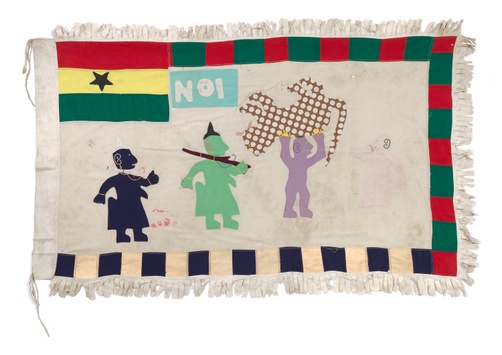
Object Label
During the seventeenth and eighteenth centuries, the Fante/Akan-speaking people from various culturally related but distinct groups who reside mainly in Ghana’s central region—formed Asafo companies, militia that protect their people and defend their territory. The Fante controlled between seventeen and twenty-four states along the coast, each independently ruled by an omanhene, or chief. Each state had between two and fourteen Asafo companies. The word Asafo derives from the words sa, meaning war, and fo, meaning people, and indeed, in the precolonial period, they engaged in warfare with enemies, protected their people from abduction by slave traders, and served as community police and organizers. Today, Asafo companies still serve as protectors in maintaining clean, safe streets, watching over the local youth, and serving ritual functions that ensure spiritual safety.
Asafo flags (mfrankaa) have been used in both war and ceremony to assert proclamations of strength, prowess over rival companies, cultural heritage, and friendship. Flag performances involve highly choreographed, athletic dances by frankakitsanyi and shouted oral storytelling by assikamba (dancer “guards”). The flags are usually rectangular textiles with plain-colored backgrounds and centrally placed, appliqued images on each side.
Between 1874 and 1957 Ghana was a British colony, a fact reflected by the flags made before March 1957, which typically contain a representation of the British Union Jack in the upper-left corner; after Ghana gained independence, the Ghanaian national colors—red, yellow, and green—were more commonly used as the canton.
The flags’ imagery exists within Fante storytelling traditions and reflects proverbial messages. Flags express the power and glory of the company at the expense of rival companies, or might represent important historical events. The visualized proverb, “The mudfish grow fat for the benefit of the crocodile,” demonstrates an alignment of the Asafo company with the strength and importance of the crocodile, and of its enemies with weak, easily captured fish. A motif of a figure holding a cock and clock bird—which sing at different times of day—signifies that the company can control time. Vultures, which according to Fante wisdom have no positive attributes, are used on flags to represent the enemy. Some motifs—like the powerful, dominant lion—are inspired by European heraldic insignia; these animals are not commonly seen in southern Ghana, but are common on Asafo flags.
–Jonah Jablons ‘17 and Alicia Russo ‘17
From the exhibition: If I Had Possession Over Judgement Day: Collections of Claude Simard (April 22 – September 24, 2017)
Ongoing Research

